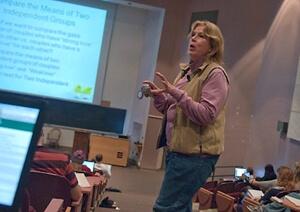Judith Christensen has spent the majority of her career working at an institution she fought to prevent from being built. The clinical and educational director of the Woodside Juvenile Rehabilitation Center in Colchester and a lecturer in psychology decided long ago that the best way to deal with her opposition to the incarceration of juveniles was to work from within the center, making an impact on the lives of those who pass through the doors of the state's only secure juvenile corrections facility.
The opening of Woodside in 1986 was especially upsetting for Christensen and her mentor, John Burchard, former UVM professor in psychology who passed away in 2004. The pair had been working toward the implementation of a new juvenile rehabilitation model based on a continuum of care and wrap-around services during Burchard's stint as commissioner of the Vermont Department of Social and Rehabilitative Services (SRS). The timing seemed perfect as the state was deinstitutionalizing its juvenile services in the wake of the closing of the Weeks School in Vergennes in 1979.
Then came the brutal beating and sexual assault of two 12-year-old girls in Essex Junction by two teenage boys who were well known in the juvenile justice system. One of the girls died while the other miraculously survived. Outraged that one of the offenders couldn't be tried as an adult at age 15, the legislature changed the law so that children as young as 10 could face trial as adults. Christensen and Burchard's plans were scrapped as the legislature pushed for the construction of Woodside despite Burchard's attempts to explain that the new law would remove the most violent juvenile offenders from the juvenile system, negating the need for Woodside altogether.
"Panic set in and the legislature wanted to build a 130-bed juvenile facility," says Christensen. "John renegotiated it down to a 30-bed facility with a secure detention area and a program based on cognitive behavior therapy." Some kids need to be stopped for their own safety and that of the community, but locking them up and not dealing with their real issues isn't going to solve anything. They still have to go back into society. My goal has always been to make sure Woodside isn't the final stop, but a place along the way to somewhere else, which is the successful and safe return to the community."
Striking a balance between teaching and practicing
For Christensen, the decision to work at Woodside was based almost entirely on her desire to help troubled youth. Christensen has worked with at-risk children since the 1960s as an undergraduate at Northeastern and graduate student at Boston College in some of the city's most impoverished areas. "My mother would say, 'Beth Ann, you were not put on this earth to make money, but to help others.'"
Torn between staying on the front lines and entering the classroom as a professor, Christensen found a way to strike a balance. Not long after receiving her doctorate in psychology from UVM in 1998, she began teaching as a part-time lecturer and currently teaches three courses including motivational psychology, thinking, and research methods. Her position at Woodside has proven beneficial for both institutions as she often uses case examples from Woodside in her courses and, in return, brings undergraduate and graduate interns to Woodside.
"I really love teaching," says Christensen. "A lot of students dread the research methods course, but I want them to realize that it's a key part of what they'll be doing. For me, I can do the clinical work, but I also have to do program evaluation, which is a form of research. As a clinical person I have to stay up-to-date on the research in my area and try to apply those principles to what we're doing at Woodside. My dream is to get students to believe that they can be good researchers and that it can lead them to a better result in clinical work."
Expanding on Burchard's model
Christensen is convinced that Burchard was ahead of his time in pushing for a more comprehensive, wrap-around services approach to rehabilitation that includes SRS, schools, family and other service providers."No matter how dysfunctional a family is, it's still the kid's family," she says. "You can remove them from it, but they eventually have to go back. We need the family to participate so they can better understand their child and learn how to deal with them."
Toward that end, Christensen and her staff of 35 professionals have made some programmatic changes at Woodside that address the varying psychological and mental health issues of each child with targeted services. Those changes, she says, have helped the state become a national leader in the implementation of progressive juvenile intervention programs.
"Every child has a story with a different beginning, middle and end," says Christensen. "And every one of them deserves to be told in its own unique way. Throughout my entire career I've never been able to use labels. You've got to see these kids for who they are and identify their strengths and build on them."

Psychology Lecturer Rethinking Juvenile Justice
ShareNovember 12, 2009